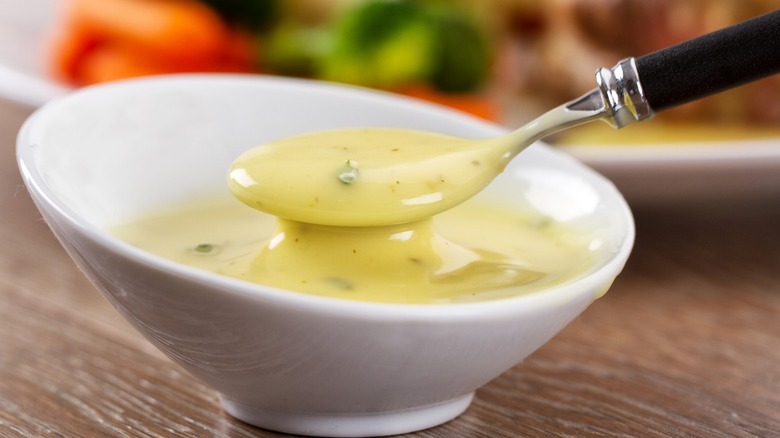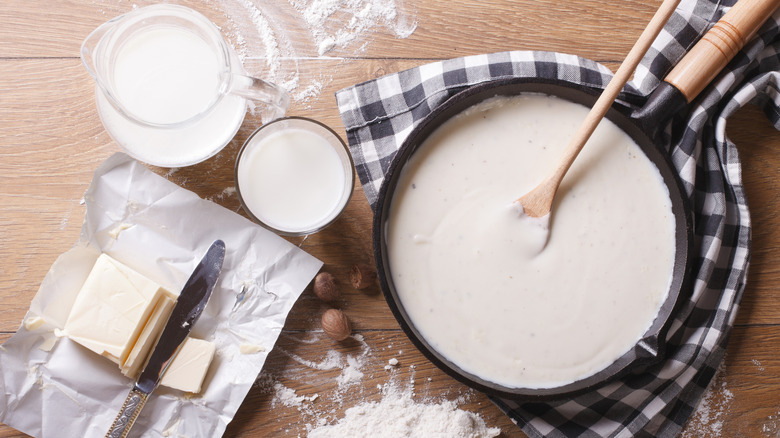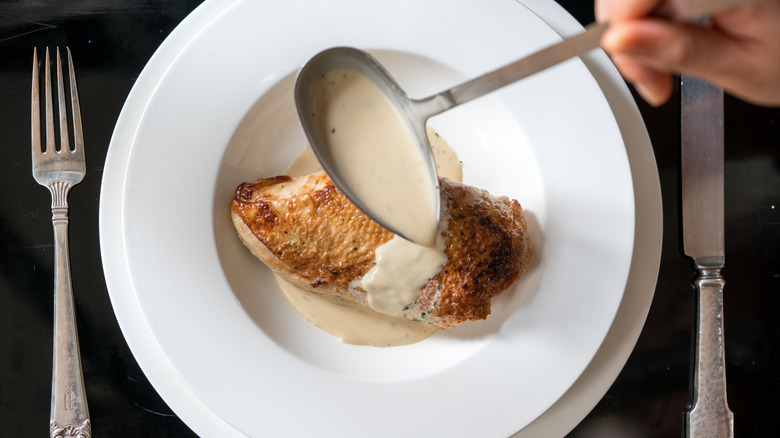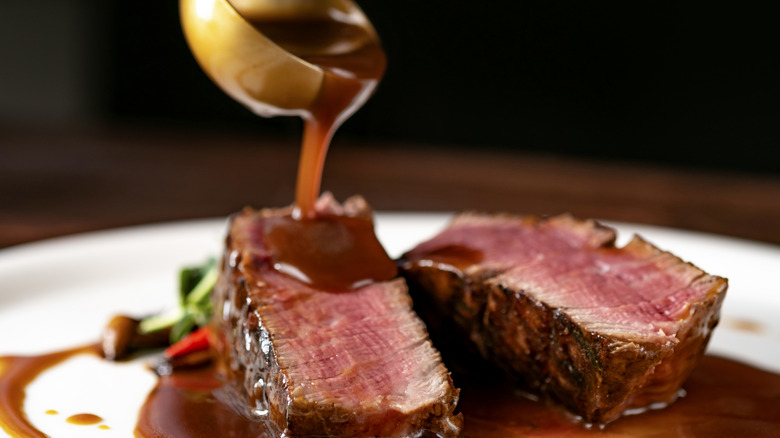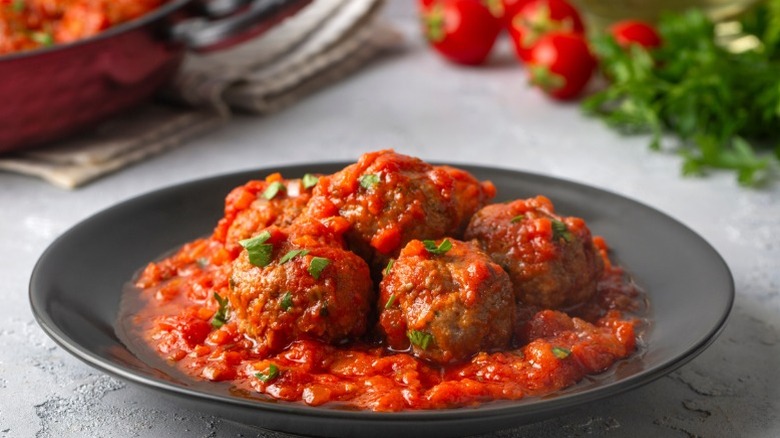What To Know About The 5 Mother Sauces Of French Cooking
In French cooking — and therefore, due to the influence of French cuisine, in culinary schools the world over — there is a concept of five mother sauces. Although the idea was first formed by the French chef Marie-Antoine Carême in the early 19th century (with four sauces), they weren't fully established as a standard until culinary pioneer Auguste Escoffier wrote about them a century later. The idea is that there are five main "mother" sauces, and countless other "daughter" sauces which are descended from those five.
Exactly which sauces are mother sauces, and which are daughter sauces, depends on who you ask and when you ask them. According to pâtissier Jules Gouffé in the 1860s, a peppery sauce called poivrade was one of the mother sauces; in the French edition of Escoffier's cookbook, mayonnaise was a mother sauce.
Today, there are five standardized mother sauces: béchamel, velouté, Espagnole, hollandaise, and tomato. All of them, except for hollandaise, are thickened with a roux which is made with cooked fat and flour. And each of the five sauces in turn can be used as the basis for creating a wide variety of other sauces.
Béchamel is a creamy, roux-based sauce
Béchamel may sound like your grandmother trying to remember Zooey Deschanel's name, but it's actually a rich, creamy sauce. It's commonly used in dishes like lasagna, chicken pot pie, and croque monsieur (or croque madame). All you need for this decadent, dependable sauce is melted butter and flour cooked to form a roux before room-temperature milk is whisked in. It gets its gentle flavor from additional seasoning such as salt, pepper, bay leaves, or even nutmeg.
In complex, multi-layer dishes like lasagna or potato au gratin, a béchamel makes for an invaluable binding agent to make sure everything holds its shape. But just on its own, it's a delight drizzled over pasta, or even chicken cordon bleu. Some of the daughter sauces that can be made from it include mornay (which is béchamel with Gruyère or parmesan cheese); soubise (béchamel with pureéd onions); and nantua (béchamel with shrimp- or crawfish-infused butter, and cream).
Velouté is a smooth sauce made from roux and stock
As you'd expect from a sauce named after the French word for "velvety", velouté is smooth. Although it's lighter and thinner than its sister béchamel, velouté starts the same way: with a roux. But instead of milk, velouté is made with a light stock — that is, a stock made from ingredients that haven't been roasted. (Roasting gives stock a more robust flavor that's very welcome in a soup, but not always necessary in a sauce.) Traditionally, this is a "white stock" made from veal bones, but velouté can be made from almost any stock. With a bit of seasoning, it can become a delicious accompaniment to all sorts of main dishes, from beef to chicken to fish.
Some of velouté's daughter sauces include sauce Allemande (also known as German sauce, and made with veal velouté, cream, egg yolks, and lemon juice); sauce Normandy (fish velouté, cream, egg yolks, oyster, and mushroom liquids); and sauce suprême (chicken velouté, cream, and mushroom liquid.)
Espagnole is a darker, more complex sauce
Although Espagnole (or Spanish sauce) starts with a roux, like béchamel and velouté, it's a good deal more complex in flavor and execution. Into the roux, a mirepoix (finely chopped carrots, onions, and celery) is stirred, along with beef stock, and various herbs. If you want to get it as smooth and luxurious as the other sauces, some straining will be required — you'll need a sieve, a cheesecloth, or ideally both. But once that meaty, unctuous flavor touches your tongue, it will be well worth it.
Espagnole's daughter sauces are perhaps more common than the sauce itself, but what fine examples they are! Demi-glace, a rich pan sauce you'll often find spooned over entrees you order at a nice restaurant, is one of this sauce's progeny; it's made from Espagnole, stock, and cooking wine. Other daughters include sauce bourguignonne (which features red wine, shallots, and herbs); sauce chasseur (with mushrooms, shallots, white wine); and sauce bigarade, which is what's traditionally served with duck à l'orange — or turkey à l'orange, which gives dark meat the star treatment. This classic consists of Espagnole, orange and lemon juice, and onions.
Hollandaise is a creamy, silky, frustrating delight
Here's where things start to get a little tricky. Unlike the previous three sauces, hollandaise doesn't begin with a roux. Instead, it's an emulsification, not too far removed from mayonnaise. And if you've ever tried to make aioli (a term which is often misused) at home, you'll know just how finicky emulsifications can be. It requires heating water, egg yolks, and vinegar in a double boiler (that is, a metal bowl placed over a pot of boiling water). Once the sauce is nice and ribbony, it's removed from the heat. Clarified butter is steadily whisked in, with care taken to make sure it doesn't get too thick, and that it doesn't break. It's fiddlesome, for sure, but who can argue with the rich result?
Hollandaise is most famously a topping for eggs benedict, but its daughter sauces are no slouch. Homemade béarnaise sauce (hollandaise with shallots and tarragon) is a delicious accompaniment to your steak, and sauce mousseline (hollandaise with heavy cream) is perfect with fish.
Tomato is just what it sounds like
Finally, there's tomato sauce — or sauce tomat, according to its fancy French name. You've almost certainly had tomato sauce before, whether you made it yourself or purchased a good store-bought marinara. The version Escoffier included in the list of mother sauces isn't too far removed from your nonna's gravy, but proper tomato sauce is deceptively complex, and it's cooked for a long time. It includes fried salt pork, vegetables, and a roux — and that's before the tomatoes even get poured in. It can be used for all your typical tomato sauce needs, but perhaps most interesting is the sheer breadth of its daughter sauces.
Marinara sauce? That's a daughter of tomato sauce. Vodka sauce? That's a daughter, too. Ketchup, hot sauce? Just tomato sauce with different seasonings and consistencies. It may not be as esoteric as you might expect from a French cookbook, but it goes to show how far and wide the concept of mother sauces has spread.
